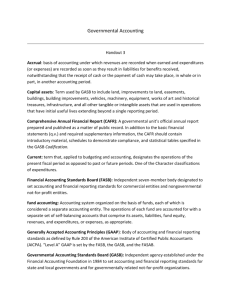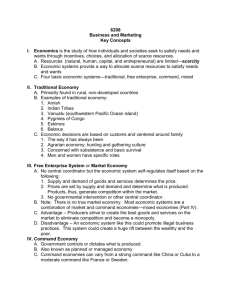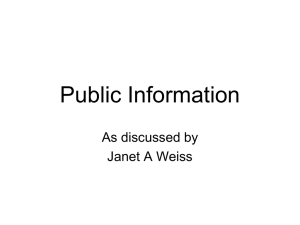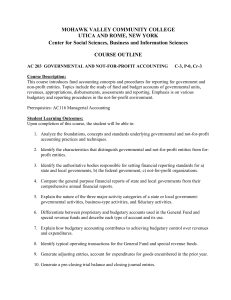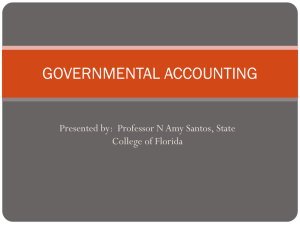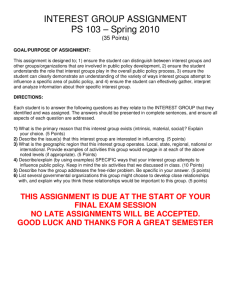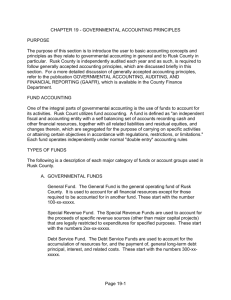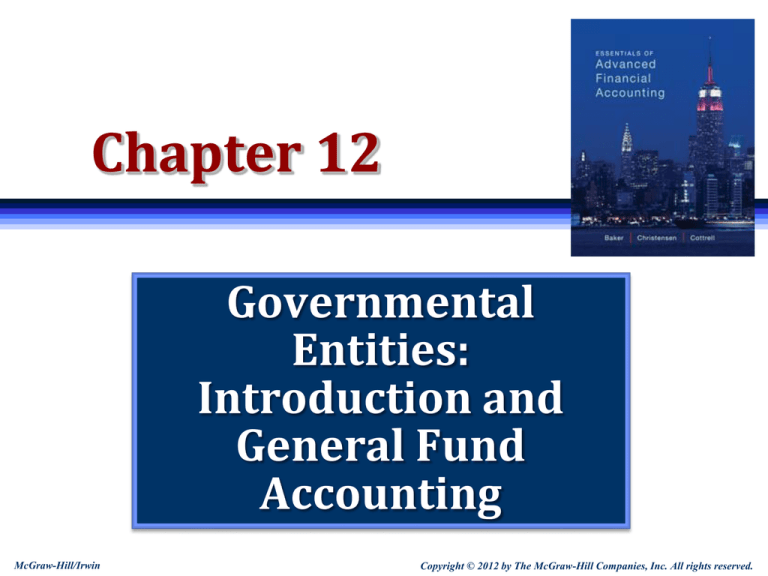
Chapter 12
Governmental
Entities:
Introduction and
General Fund
Accounting
McGraw-Hill/Irwin
Copyright © 2012 by The McGraw-Hill Companies, Inc. All rights reserved.
Learning Objective 1
Understand and explain the
basic differences between
governmental and private
sector accounting.
12-2
Overview
Governmental entities have operating
objectives different from those of commercial
entities.
As a result, governmental accounting is
different from accounting for commercial
enterprises.
12-3
Overview
Nature of governmental entities
1.
Collect resources and make expenditures to fulfil
societal needs
2.
Absence of profit motive except for some
activities
3.
Have legal authorization for their existence,
conduct revenue-raising through the power of
taxation, and have mandated expenditures they
must make to provide their services
4.
Control mechanism – Use of comprehensive
budgetary accounting
12-4
Overview
Nature of governmental entities
5.
Accountability for the flow of financial resources
is a chief objective
6.
Typically are required to establish separate
funds to carry out various missions; each fund is
an independent accounting and fiscal entity
7.
Many fund entities do not record fixed assets or
long-term debt in their funds
8.
An important objective of governmental
financial reporting is accountability
12-5
History of Governmental Accounting
History
Before 1984, directed by the Municipal Finance
Officers Association (MFOA)
In 1934, the first statement on local
governmental accounting published
In 1968, Governmental Accounting, Auditing,
and Financial Reporting (GAAFR) was published
The GAAFR is periodically updated to include the
most recent governmental reporting standards
12-6
History of Governmental Accounting
History
1974 –The American Institute of Certified Public
Accountants (AICPA) published an industry
audit guide, in which it stated that “except as
modified in this guide, they [GAAFR] constitute
generally accepted accounting principles”
March 1979 – The National Council on
Governmental Accounting (NCGA) issued its
Statement No. 1, “Governmental Accounting and
Financial Reporting Principles” (NCGA 1)
12-7
History of Governmental Accounting
History
1984 – Governmental Accounting Standards
Board (GASB) established
GASB Statement No. 1
The GASB stated that all NCGA statements and
interpretations issued and in effect on that date were
accepted as generally accepted accounting principles
for governmental accounting
GASB Statement No. 34
Established government-wide financial statements to
be prepared on the accrual basis of accounting and an
array of fund-based financial statements
12-8
History of Governmental Accounting
History
The GASB continues to issue new standards to
meet the information needs of users of the
financial reports of governmental units.
Accounting for governmental entities is given
the general name of fund accounting.
12-9
The Governmental Accounting Standards Board
(GASB)
GASB
Created in 1984
A sister organization to the FASB
Establishes GAAP for state and local units
No authority to establish GAAP for the federal
government
Seven members—simple majority vote needed
(4 votes)
12-10
GAAFR: “The Blue Book”
“Governmental Accounting, Auditing,
and Financial Reporting”
Published by the Government
Finance Officers Association (GFOA).
Neither prescribes nor
authoritatively interprets GAAP for
governmental units.
Provides detailed guidance (many
examples) for applying
governmental GAAP.
Widely used by governmental units.
12-11
Practice Quiz Question #1
Which of the following statements is correct?
a. The GASB is responsible to set standards
for governmental units and not-for-profit
entities.
b. The FASB was created in 1972 and sets
standards for governmental units.
c. The Blue Book contains financial
accounting standards for privately held
governmental agencies and companies.
d. The GASB is responsible for setting
standards for state and local governments
but not the federal government.
12-12
Learning Objective 2
Understand and explain
major concepts of
governmental accounting.
12-13
Major Concepts of Governmental Accounting
Elements of a Statement of Financial Condition
1.
Assets are resources with present service capacity that
the entity presently controls.
2.
Liabilities are present obligations to sacrifice resources
that the entity has little or no discretion to avoid.
3.
A deferred outflow of resources is a consumption of net
assets that is applicable to a future reporting period.
4.
A deferred inflow of resources is an acquisition of net
assets that is applicable to a future reporting period.
5.
Net position is the residual of all other elements
presented in a statement of financial condition.
12-14
Major Concepts of Governmental Accounting
Elements of a the resource flows statements
1.
An outflow of resources is a consumption of net assets
that is applicable to the current reporting period
2.
An inflow of resources is an acquisition of net assets
that is applicable to the current reporting period
12-15
Major Concepts of Governmental Accounting
Expendability of resources versus capital
maintenance objectives
Commercial Enterprises
Government Entities
Measurement focus
The flow of all economic
resources
Changes in current financial
resources available to
provide services to the
public in accordance with the
budget
Method of
accounting
Accrual method
Modified accrual method
Balance sheet
Contains both current and
noncurrent assets and
liabilities, and the change in
retained earnings reflects
the company’s ability to
maintain its capital
investment
Reports only current assets,
current liabilities, and a fund
balance
12-16
Practice Quiz Question #2
Which of the following statements is true?
a. Governmental units use the modified
accrual basis of accounting and focus on
the flow of all economic resources.
b. Commercial enterprises use the modified
accrual basis of accounting and focus on
the flow of all economic resources.
c. The balance sheets of governmental units
contain long-term assets and liabilities.
d. The balance sheets of commercial entities
contain a fund balance.
12-17
Learning Objective 3
Understand and explain the
differences between the
various governmental fund
types.
12-18
The Nature & Diversity of Governmental Activities
The operations of governmental entities are
classified into three categories:
Governmental—these activities do not
resemble commercial activities.
Proprietary—these activities resemble
commercial activities. Can measure profitability
or capital maintenance.
Fiduciary—holding and managing assets owned
by others (e.g., pension assets).
12-19
Use of Fund Accounting
Fund Accounting
Accounting for certain activities separately from
all other operations.
Fund definition: A fiscal and accounting entity
with a self-balancing set of accounts (like a
branch or a division of a commercial entity).
The General Fund: The main and largest
fund—records most routine transactions.
The difference between a fund’s assets and
liabilities is called:
Government and
Fiduciary-type Funds
Fund Balance
Proprietary Funds
Net Assets
12-20
Major Concepts of Governmental Accounting
Three Types of Funds
Governmental Funds
Proprietary Funds
Used to provide basic governmental services to the
public
Each entity creates only one general fund, but it may
create more than one of each of the other types of
funds
The objective is to recover the unit’s costs through
user charges
Fiduciary Funds
12-21
Major Concepts : Types of Funds
Governmental Funds
General Fund: Accounts for all activities not
required to be accounted for in another fund.
Special Revenue Fund: A clone of the General
Fund.
Capital Projects Funds
Debt Service Funds
Permanent Funds
12-22
Major Concepts : Types of Funds
Proprietary Funds
Enterprise Funds:
Provides services primarily to nongovernmental
users
Examples: City-owned utilities or recreational
facilities
Internal Service Funds:
Provides services solely to governmental
departments.
12-23
Major Concepts : Types of Funds
Fiduciary Funds
Trust Funds
Pension (and similar) Trust Funds
Investment Trust Funds
Private-Purpose Trust Funds (these activities
do not benefit the government unit)
Agency Funds
12-24
Major Concepts of Governmental Accounting
Governmental Fund Types
General fund
Accounts for all financial resources except for those
accounted for in another fund. Includes transactions
for general governmental services provided by the
executive, legislative, and judicial operations of the
governmental entity.
Special revenue
fund
Accounts for the proceeds of specific revenue sources
that are restricted for specified purposes.
Capital projects
fund
Accounts for financial resources for the acquisition or
construction of major capital facilities that benefit
many citizens, such as parks and municipal buildings.
Accounts for the accumulation of resources for, and the
payment of, general long-term debt principal and
interest.
Debt service fund
Permanent fund
Accounts for resources that are restricted such that
only earnings, but not principal, may be used in support
of governmental programs that benefit the government
or its citizenry.
12-25
Major Concepts of Governmental Accounting
Proprietary Fund Types
Enterprise fund
Internal service fund
Accounts for operations of governmental units that
charge for services provided to the general public.
Accounts for the financing of goods or services provided
by one department or agency to other departments or
agencies of the governmental unit. Services are offered
only to governmental agencies.
Fiduciary Fund Types and Similar Component Units
Pension (and other
employee benefit)
trust fund
Investment trust fund
Private-purpose trust
fund
Agency fund
Accounts for resources required to be held in trust for
the members and beneficiaries of pension plans, other
post-employment benefit plans, or other EBPs.
Accounts for the external portion of investment pools
reported by the sponsoring government.
Accounts for all other trust arrangements under which
the fund’s resources are to be used to benefit specific
individuals, private organizations, or other
governments.
Accounts for assets held by a governmental unit in an
agency capacity for employees or for other
governmental units.
12-26
Practice Quiz Question #3
The three major categories of
governmental funds are:
a. Governmental, commercial, and
proprietary.
b. Governmental, trust, and fiduciary.
c. Enterprise, proprietary, and fiduciary .
d. Governmental, proprietary, and
fiduciary.
e. Governmental Service, proprietary,
and commercial
12-27
Learning Objective 4
Understand and explain basic
concepts for financial reporting
in governmental
accounting.
12-28
Financial Reporting of Governmental Entities
Governmental funds – financial
statements
Balance sheet
Statement of revenues, expenditures and
changes in fund balance
The five governmental funds use the current
financial resources measurement focus
12-29
Fund Accounting
Specific General Ledger Accounts Used
defined by GASB 54:
Government and
Fiduciary-type
Funds
Fund Balance
Non-spendable
Spendable:
• Restricted
• Limited
• Assigned
• Unassigned
Proprietary Funds
Net Assets
Restricted
Unrestricted
12-30
Financial Reporting of Governmental Entities
Balance Sheet for Governmental Funds
Assets (financial resources available for current use;
presented in order of liquidity)
Total Assets
Liabilities and Fund Balances:
Liabilities (due and expected to be paid from current
financial resources; presented in order of due date)
Fund Balances
Nonspendable
Spendable:
Restricted
Limited
Assigned
Unassigned
Total Liabilities and Fund Balances
$X,XXX
$X,XXX
$ XXX
$ XX
XX
XX
XX
XX
XX
$X,XXX
12-31
Financial Reporting of Governmental Entities
Statement of revenues, expenditures, and
changes in fund balance
Often called the operating statement of the
governmental funds
Statement of Revenues, Expenditures, and Changes in Fund Balance
Revenues (recognized when both measurable and available; presented
by source of revenue)
$XX,XXX
Expenditures (approved decreases in net financial resources; presented
by function and character)
X,XXX
Excess of Revenues over Expenditures
$
XXX
Other Financing Sources or Uses (other increases or decreases in net
financial resources available, such as bond issue proceeds and interfund
transfers)
XX
Special Items and Extraordinary Items
(X)
Net Change in Fund Balance
$
XX
Fund Balance—Beginning
XXX
Fund Balance—Ending (reconciles to total fund balance on balance sheet) $
XXX
12-32
Practice Quiz Question #4
Which of the following is true?
a. The operating statements of governmental
entities focus on revenues and expenses.
b. The balance sheets of governmental entities
focus on the normal accounting equation:
Assets – Liabilities = Owner’s Equity.
c. The operating statements of governmental
entities focus on revenues and liabilities.
d. The balance sheets of governmental entities
focus a modified accounting equation:
Assets – Liabilities = Fund Balance.
e. All governmental fund balances are
spendable.
12-33
Learning Objective 5
Understand and explain the
basic differences in the
measurement focus and basis
of accounting between
governmental and private sector
accounting.
12-34
Measurement Focus And Basis Of Accounting
(MFBA)
Measurement Focus
What flows to measure for operations.
Basis of Accounting
When should transactions and events be recognized
in the financial statements.
12-35
MFBA: Governmental Activities
Measure flow:
Current financial resources
Basis of Accounting:
Modified accrual basis of accounting
•
Present a Statement of Revenues and
Expenditures and Changes in Fund Balance
- shows financial resources received and spent.
- shows change in net financial resources
available for spending in the near future.
12-36
MFBA: Current Financial Resources
Current financial resources:
Cash, property tax receivables, prepaids, and
supplies inventories.
Claims against current financial resources:
Wages, payroll taxes, payables to vendors, and
liabilities expected to be paid in the near future
(typically within 60 days after the year-end).
12-37
MFBA: Proprietary and Fiduciary Activities
Measure flow:
All economic resources
Basis of Accounting:
Accrual basis of accounting
• Present a Statement of Revenues and Expenses
- shows the change in the economic condition
• Also present a Statement of Cash Flows
12-38
Measurement Focus and Basis of Accounting
The modified accrual basis is used in funds
that have a flow of current financial
resources measurement focus
The five governmental funds have this focus
The accrual basis is used in funds that have a
flow of economic resources measurement
focus
Proprietary funds and fiduciary funds have this
focus
The government-wide financial statements
are based on the accrual basis
12-39
Measurement Focus and Basis of Accounting
Modified Accrual Basis Funds
Governmental funds
General Fund
Special Revenues Fund
Capital Projects Funds
Debt Service Funds
Permanent Funds
12-40
Measurement Focus and Basis of Accounting
Accrual Basis Funds
Proprietary funds
Enterprise Funds
Internal Service Funds
Fiduciary funds (3 Trust & 1 Agency)
The two propriety funds and the three trust
funds have either a profitability or capital
maintenance orientation.
12-41
Measurement Focus and Basis of Accounting
Modified Accrual Basis
Revenues: Recognize in period in which they
become available and measurable.
Available means: Collectible within the current
period or soon enough thereafter to be used to pay
current period liabilities.
Expenditures: Recognize in the accounting
period in which the liabilities are both
measurable and incurred and are payable out of
current financial resources.
One exception exists for interest on general longterm liabilities.
12-42
Measurement Focus and Basis of Accounting
Recognition of revenue: how revenues are recognized
depends on the category
1.
Derived tax revenues, resulting from assessments on exchange
transactions
2.
The asset is recognized when the underlying transaction occurs or
resources are received, whichever comes first.
Revenue recognition depends on the accounting basis used to measure
the transaction.
Imposed nonexchange revenues, resulting from assessments on
nongovernmental entities, including individuals
The asset is recognized when the government has an enforceable legal
claim to the resources or the resources are received, whichever comes
first.
Revenue recognition is made in the period when use of the resources
for current expenditures is first permitted or required, or at the time
the asset is recorded if no time restriction on the fund’s use of the
resources exists.
12-43
Measurement Focus and Basis of Accounting
Recognition of revenue: how revenues are recognized
depends on the category
3.
Imposed nonexchange revenues, resulting from assessments on
nongovernmental entities, including individuals
4.
5.
The asset is recognized when the government has an enforceable legal
claim to the resources or the resources are received, whichever comes
first.
Revenue recognition is made in the period when use of the resources
for current expenditures is first permitted or required, or at the time
the asset is recorded if no time restriction on the fund’s use of the
resources exists.
Government-mandated nonexchange transactions, resulting from
one governmental unit’s provision of resources to a governmental
unit at another level and the requirement that the recipient use the
resources for a specific purpose
Voluntary nonexchange transactions, resulting from legislative or
contractual agreements, other than exchanges
12-44
Practice Quiz Question #4
The modified accrual basis of accounting:
a. recognizes revenues when earned and
expenditures when incurred.
b. recognizes revenues when they become
available and measureable and expenditures
when liabilities become measurable and
incurred.
c. recognizes revenues when earned and
expenses when incurred
d. recognizes revenues when they become
available and measureable and expenditures
when they become available and spendable.
12-45
Learning Objective 6
Understand and explain basic
budgeting concepts in
governmental accounting.
12-46
Budgetary Aspects of Governmental Operations
Budgets
Used in governmental accounting to assist in
management control and to provide the legal
authority to levy taxes, collect revenue, and
make expenditures in accordance with the
budget
Types of budgets:
Operating budgets
Capital budgets
12-47
Budgetary Aspects of Governmental Operations
Appropriation: The statutory authorization for spending a
budgeted amount during a coming year.
Annual Budgets for the General Fund and the Special
Revenue Funds are always recorded in the general ledger
for control purposes.
Also done for Capital Projects Funds and Debt Service Funds if
useful.
Encumbrances: Commitments related to unperformed
(executory) contracts for goods or services.
Special general ledger accounts are used to record
encumbrances—the purpose is to prevent spending more
than has been appropriated.
Budget entries have no effect on reported operations.
12-48
Introduction: Budget / Expenditure Process
1. Budget—Recorded in the books
CAPITAL LETTERS (legally binding)
2. Expenditures
Appropriation (authorization of the expenditure)
Encumbrance (set aside or reserve part of the
budgetary appropriation)
Expenditure
Disbursement
12-49
Budgetary Aspects of Governmental Operations
Recording the Operating Budget
Assume that at January 1, 20X1, the first day of the new fiscal period,
the city council of Barb City approves the operating budget for the
general fund, providing for $900,000 in revenue and $850,000 in
expenditures. Approval of the budget provides the legal authority to
levy the local property taxes and to appropriate resources for the
expenditures. The entry made in the general fund’s accounting records
on this date is as follows:
January 1, 20X1
(1) ESTIMATED REVENUES CONTROL
APPROPRIATIONS CONTROL
BUDGETARY FUND BALANCE—UNASSIGNED
900,000
850,000
50,000
Record general fund budget for year.
12-50
Budgetary Aspects of Governmental Operations
The ESTIMATED REVENUES CONTROL account is an
anticipatory asset.
The APPROPRIATIONS CONTROL account is an
anticipatory liability.
The excess of estimated revenues over anticipated
expenditures is the budget surplus and is recorded to
BUDGETARY FUND BALANCE—UNASSIGNED.
Some approved budgets have budget deficits in which
expected expenditures exceed anticipated revenue.
These budgets are recorded with a debit to BUDGETARY
FUND BALANCE—UNASSIGNED.
12-51
Example: Budget / Expenditure Process
Assume a municipality approves the following budged:
$900,000 in Revenues
$850,000 in Appropriations
An appropriation of $15,000 is approved, but the final voucher
is paid for only $14,000.
12-52
Example: Budget / Expenditure Process
1. Budget
ESTIMATED REVENUES CONTROL
APPROPRIATIONS CONTROL
BUDGETARY FUND BALANCE—UNASSIGNED
900,000
850,000
50,000
2. Expenditures
Appropriation
Authorization of the expenditure (Annual Budget)
Person with authority (each expenditure authorized)
Encumbrance
ENCUMBRANCES
BUDGETARY FUND BALANCE—ASSIGNED FOR ENC.
15,000
15,000
12-53
Example: Budget / Expenditure Process
2. Expenditures
Expenditure
BUDGETARY FUND BALANCE—ASSIGNED FOR ENC.
15,000
ENCUMBRANCES
15,000
Disbursement
Expenditures
14,000
Vouchers Payable
Vouchers Payable
Cash
14,000
14,000
14,000
12-54
Text Page 837
12-55
Practice Quiz Question #4
Why to state and local governments record
encumbrances?
a. To ensure that the entity earns sufficient
revenues to achieve profitability.
b. To ensure that the entity does not spend more
than has been appropriated.
c. To ensure that all sub-entities within the
organization are not encumbered.
d. To ensure that the entity spends at least as
much as has been appropriated.
12-56
Learning Objective 7
Make calculations and record
journal entries for the general
fund.
12-57
Accounting for Expenditures
The Expenditure Process
Step 1. Appropriation
Step 2. Encumbrance
An encumbrance is a reservation of part of the budgetary
appropriation and is recognized at the time an order is placed
for goods or services.
Step 3. Expenditure
The budget provides the appropriating authority to make future
expenditures.
An expenditure and a corresponding liability are recorded when
the governmental entity receives the goods or services ordered
in Step 2.
Step 4. Disbursement
A disbursement is the payment of cash for expenditures.
12-58
Comparison of Accounting for Lapsing and
Nonlapsing Encumbrances at Year-End
12-59
Two Ways to Account for Supplies Inventories
Consumption Method
The preferred method—it parallels business practice.
The acquisition of inventory is treated as the conversion
of resources (debit Inventory).
The use of inventory is treated as an outflow of
resources (credit Inventory and debit Expenditures or
Expenses).
Purchases Method
The acquisition of inventory is treated as an outflow of
resources (debit Expenditures or Expenses).
12-60
Two Ways to Account for Supplies Inventories
The specific method to follow depends on the governing
unit’s policy and how inventory expenditures are included
in the budget.
Immaterial inventories need not be shown on the balance
sheet
If the inventory is material, it is presented as an asset on the
balance sheet.
An amount equal to the inventory also should be shown as a
reservation of the fund balance, indicating that that amount is
no longer expendable.
12-61
Accounting for Expenditures
12-62
Accounting for Expenditures
Accounting for fixed assets
Governmental funds: Recognized as an expenditure in
the year the asset is acquired
Proprietary funds: Account for acquisitions of capital
assets in the same manner as commercial entities
Works of art and historical treasures
For the purposes of government-wide financial
statements, governments should capitalize these assets
at their historical costs at acquisition or at their fair
values at the date of the contribution
12-63
Accounting for Expenditures
Long-term debt and capital leases
The governmental funds record the proceeds from a
bond issue as a debit to Cash and a credit to Bond Issue
Proceeds, an other-financing source.
Bond issue proceeds are not revenue because the bonds
must be repaid.
Bonds are not reported on the governmental funds’
balance sheets but only on the government-wide
financial statements.
Capital leases are accounted for in a manner similar to
long-term debt.
12-64
Accounting for Expenditures
Investments
GASB 31 established a general rule of fair market
valuation for investments held by a government entity.
Changes in the fair value of investments should be
recognized as an element of investment income in the
operating statement (or statement of activities) of each
fund.
GASB 40 requires footnote disclosures of the policies
and the profiles of the government’s investment
portfolios.
12-65
Group Exercise:
Comprehensive General Fund Entries
The City of Cottersen, Texas is a small town with a population of
approximately 15,000. The city noted the following transactions
during fiscal 20X8.
REQUIRED
1. Prepare General Fund journal entries only for these items.
2. Prepare closing entries at 6/30/X8.
3. Prepare a Statement of Revenues, Expenditures, and
Changes in Fund Balance as of 6/30/X8.
4. Provide a summary of the fund balance by category as of
6/30/X8.
12-66
Group Exercise:
Requirement 1 (Journal Entries)
1. The Cottersen city council approved the following budget:
Estimated revenues
$820,000
Authorized expenditures (including
$65,000 reappropriated for encumbrances
outstanding at 6/30/X7 that had lapsed)
720,000
Authorized transfers out to other funds
($35,000 and $20,000)
55,000
Estimated inflow from the discontinuance of
the Auto Repair Internal Service Fund
25,000
12-67
Group Exercise:
Requirement 1 (Journal Entries)
2. The city levied property taxes totaling $570,000. Of this
amount, $10,000 was estimated to be uncollectible.
Collections during the year totaled $525,000, of which
$12,000 were associated with property taxes levied in the
prior year that had been declared delinquent at the end of the
prior year. All of the remaining property taxes receivable at
the beginning of the current year, totaling $5,000, were
written off as uncollectible. The net realizable amount at
6/30/X8 ($11,000) is expected to be collected within 60 days.
12-68
Group Exercise:
Requirement 1 (Journal Entries)
2. The city levied property taxes totaling $570,000. Of this
amount, $10,000 was estimated to be uncollectible.
Collections during the year totaled $525,000, of which
$12,000 were associated with property taxes levied in the
prior year that had been declared delinquent at the end of the
prior year. All of the remaining property taxes receivable at
the beginning of the current year, totaling $5,000, were
written off as uncollectible. The net realizable amount at
6/30/X8 ($11,000) is expected to be collected within 60 days.
Property Taxes
Receivable—Delinquent
BB 17,000
Allowance for
Uncollectibles—Delinquent
NRV = 11,000
6,000 BB
12,000 Collected
Given 5,000
5,000
Write
off
5,000
1,000 Left over
Close out 12-69
Group Exercise:
Requirement 1 (Journal Entries)
2. The city levied property taxes totaling $570,000. Of this
amount, $10,000 was estimated to be uncollectible.
Collections during the year totaled $525,000, of which
$12,000 were associated with property taxes levied in the
prior year that had been declared delinquent at the end of the
prior year. All of the remaining property taxes receivable at
the beginning of the current year, totaling $5,000, were
written off as uncollectible. The net realizable amount at
6/30/X8 ($11,000) is expected to be collected within 60 days.
12-70
Group Exercise:
Requirement 1 (Journal Entries)
3. The estimated revenues for the year include a $44,000
entitlement from the federal government. During the year,
the city received $50,000.
12-71
Group Exercise:
Requirement 1 (Journal Entries)
4. The City’s income taxes, sales taxes, permits, licenses, and
other miscellaneous revenues totaled 225,000.
12-72
Group Exercise:
Requirement 1 (Journal Entries)
5. Encumbrances outstanding at the beginning of the year
totaled $60,000. The goods and services related to these
encumbrances were received along with invoices for $58,000.
12-73
Group Exercise:
Requirement 1 (Journal Entries)
5. Encumbrances outstanding at the beginning of the year
totaled $60,000. The goods and services related to these
encumbrances were received along with invoices for $58,000.
12-74
Group Exercise:
Requirement 1 (Journal Entries)
6. Purchase orders and contracts totaling $380,000 were
entered into during the year. For $340,000 of this amount,
invoices that totaled $336,000 for services and goods were
received. The city generally allows encumbrances
outstanding at year-end to laps but reappropriates the
amounts in the following year to honor the encumbrances.
Of the $336,000 invoiced, $75,000 relates to the acquisition
of supplies inventory. The city uses the consumption
method for accounting for supplies.
12-75
Group Exercise:
Requirement 1 (Journal Entries)
6. Purchase orders and contracts totaling $380,000 were
entered into during the year. For $340,000 of this amount,
invoices that totaled $336,000 for services and goods were
received. The city generally allows encumbrances
outstanding at year-end to laps but reappropriates the
amounts in the following year to honor the encumbrances.
Of the $336,000 invoiced, $75,000 relates to the acquisition
of supplies inventory. The city uses the consumption
method for accounting for supplies.
12-76
Group Exercise:
Requirement 1 (Journal Entries)
7. Payroll and other items not involving the use of purchase
orders and contracts totaled $270,000. This amount does
not include interfund billings.
8. Cash disbursements (not including payments to other
funds) totaled $750,000.
12-77
Group Exercise:
Requirement 1 (Journal Entries)
9. The Auto Repair internal service fund was discontinued as
determined by the city council at the beginning of the year.
The actual amount disbursed to the General Fund when the
fund was discontinued was $22,000.
10. A payment was made for $30,000 to the Electric Utility
Enterprise Fund to make up its operating deficit, which had
originally been estimated to be $35,000.
12-78
Group Exercise:
Requirement 1 (Journal Entries)
11. A $20,000 payment was made to a Capital Projects fund to
cover a portion of street improvements (which was exactly
the amount budgeted).
12-79
Group Exercise:
Requirement 1 (Journal Entries)
12. The Electric Utility Enterprise fund billed the city for a total
of $28,000 for electricity used by the city and supplied by
the Electric Utility. The cash disbursements throughout the
year for periodic billings totaled $24,000.
12-80
Group Exercise:
Requirement 1 (Journal Entries)
13. The City disbursed $79,000 to the City Center for the
Performing Arts Enterprise Fund as a loan. The repayment
is expected in three years.
12-81
Group Exercise:
Requirement 1 (Journal Entries)
14. A physical count of the supplies inventory at year-end
indicates that the balance decreased from $44,000 to
$41,000 during the year.
12-82
Group Exercise:
Requirement 2 (Closing Entries)
12-83
Group Exercise:
Requirement 2 (Closing Entries)
12-84
Group Exercise: Requirement 2 (Statement of Revenues,
Expenditures, and Changes in Fund Balance)
Budget
Variance
Favorable
Actual (Unfavorable)
Revenues:
$1,000)
Expenditures:
Excess of Revenues over Expenditures
Property taxes ($560,000 +
$570,000) $561,000) $(9,000))
Intergovernmental entitlement 44,000)
50,000)
6,000)
Miscellaneous 206,000) 225,000)
Total Revenues$820,000)
$836,000) $16,000)
19,000)
720,000) 715,000) 5,000)
$100,000) $121,000) $21,000)
Other Financing Sources (Uses):
Transfer in from Auto RepairInternal Service
Fund
$25,000)
$22,000) $(3,000)
Transfers Out—
to Electric Utility Enterprise
Fund
(35,000)
(30,000) 5,000)
to Capital Projects Fund (20,000)
(20,000)
(Uses)
Excess of Revenues over Expenditures
and Other Financing Uses:
100,000)
0)
Total Other Financing Sources
$(30,000) $(28,000)$2,000)
$70,000) $93,000) $(7,000)
Fund Balance – 7/1/X7
100,000)
0)
Fund Balance – 6/30/X8 $170,000)
$193,000) $23,000)
)
Note:
The large favorable variance is attributable primarily to encumbrances of $40,000 outstanding at year-end
that will be reflected as expenditures in the following year.
12-85
Group Exercise:
Requirement 4 (Fund Balance Summary)
Fund Balance:
Inventory
Services
Nonspendable:
Supplies
$ 41,000
Spendable:
Assigned for
Governmental
40,000
Unassigned
112,000
Balance
Total Fund
$193,000
12-86
Learning Objective 8
Make calculations and record
journal entries for basic
interfund activities.
12-87
Interfund Activities
12-88
Overview of Accounting and Financial Reporting for
the General Fund
12-89
Overview of Accounting and Financial Reporting for
the General Fund
12-90

